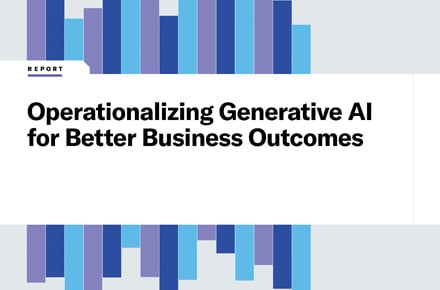How composable practices can help organizations survive disruption
diciembre 8, 2022 / Madhukar Govindiah
Short on time? Read the key takeaways:
- Composable digital business practices can inspire enterprises to thrive in a turbulent environment by significantly improving resilience, adaptability and readiness to change.
- Composability builds on several widely used software practices and approaches, including modular design, service-oriented architecture, componentization, decoupling, micro-services, reusability, event-driven architecture, continuous delivery and API-centric integrations.
- Composability is a new way of thinking that welcomes change as an asset instead of a burden.
- A composable business changes business strategies, organizational structures and ways of working — from fixed, siloed, and long-term to continuously reviewed, collaborated and evolved to realize short-term and long-term goals.
Enterprises must continually adapt amid economic uncertainty to survive today's ever-changing technology and market landscape. This is nothing new. As renowned management scholar Peter Drucker once said, "The greatest danger in times of turbulence is not the turbulence; it is to act with yesterday's logic." That statement still rings true.
How can change-resistant organizations avoid being left behind? Consider implementing composable digital business practices.
Composability accelerates digital business in key fundamental tenets that combine mindset, techniques and tools. This way of thinking can inspire enterprises to thrive in a turbulent environment by significantly improving resilience, adaptability and readiness to change.
The concept looks to be gaining momentum as well. Gartner says 63% of chief information officers at organizations with high composability reported superior business performance and an increase ability to pursue new value streams through technology.
Composable practices help businesses survive amid disruptions, but the concept does require fundamental shifts in business thinking, architecture and technology. To better understand, let's dig into the core principles of composable digital business practices and the three pillars central to constructing them in your organization.
What is composability?
Composability creates an organization from interchangeable building blocks, according to Gartner. This modular setup enables businesses to respond and adapt depending on external (or internal) factors, such as a shift in customer values or sudden supply chain or materials changes.
Composability builds on several widely used software practices and approaches, including modular design, service-oriented architecture, componentization, decoupling, micro-services, reusability, event-driven architecture, continuous delivery and API-centric integrations.
Exploring the core principles of composability
The core design principles of composability act as guardrails, helping to boost resilience and adaptability. Gartner lists these principles as modularity, autonomy, orchestration and discovery. Here is how each principle exemplifies this concept:
- Modularity: The overall solution should be divided into granular, managed components. These building blocks — packaged business capabilities (PBCs) — can be scaled independently and cater to controlled changes. Each modular PBC should represent a well-defined business capability. Inventory management, user management or e-commerce shopping cart software are examples of PBCs.
- Autonomy: Each composable component must be independent of others and should allow for changes to the component with no or minimal impact on others. The integrity of the change should be maintained during all subsequent changes.
- Orchestration: The interaction between components should be uniform and defined, allowing the mixing and matching of components and easy composition of the required processes. API and event-driven interactions are standard mechanisms for integrating composable components.
- Discovery: Each composable component should be easily discoverable and understandable. A composable enterprise should be able to track changes, understand opportunities for change and guide quick, secure reactions.
Here's a real-life business example of how we used these principles to transform a large mortgage solution for a leading financial institution.
We incrementally broke down a monolithic legacy system into modular and well-rounded business components using a layered API strategy that consisted of system, domain and easily discoverable experience APIs. This layered API strategy ensured that the existing implementations and business functions were reused while the outer API wrappers with clearly defined communication protocols provided the required modularity and autonomy. We orchestrated the interaction between system components using an industry-leading API and integration platform.
Today the transformed system, along with the simultaneously transformed team culture with agility and automation, is one of our finest examples of composable systems with flexible and easily changeable business components that address growing business needs or newer technology trends. Change is no longer resisted but welcomed as a natural improvement.
Defining the three pillars of composability
Three pillars, which Gartner also calls building blocks, hold up the concept of composability: composable thinking, composable business architecture and composable technologies. Let's break down each:
Composable thinking
Composability is as much about a mindset shift as it is about a business strategy and technologies. It is a new way of thinking that welcomes change as an asset instead of a burden. Composable business practices do not see the aversion to change as the norm. Instead, change is a trusted tool of choice to achieve smaller and more significant business outcomes.
Here are some examples of fundamental changes compared to traditional thinking:
- "If it ain't broke, don't fix it" no longer holds true. Every component is a building block and needs to be changeable.
- "System of systems" is the new norm. Large, tightly integrated systems are outdated.
- Stability is no longer the only overriding parameter. Instead, flexibility and choice are now equal contenders.
- Design to change, think and build modular solutions.
- Change often. Change to grow and not just to keep up.
Composable business architecture
Composable business architecture aims to apply these principles to foundational business tenets. From business models, enterprise operations to strategy, these principles can effectively address the perceived risk of change and maximize business value. Key activities include:
- Dividing the business entities into a system of building blocks — a composable entity of entities (modularity)
- Validating that the entity can be changed independently of each other (autonomy)
- Defining streamlined interaction mechanisms between entities (orchestration)
- Defining tools to track entities and identify opportunities for changes and new interactions (discovery)
A composable business changes business strategies, organizational structures and ways of working — from fixed, siloed, and long-term to continuously reviewed, collaborated and evolved to realize short-term and long-term goals. Business capabilities are constantly fine-grained to support modularity and autonomy principles.
Composable technology
Composable technology builds on several software practices. However, there are subtle differences:
- Focus shifts from technical APIs to PBCs or API products, which enables assembly and dynamic reassembly of applications
- Assembling PBCs into working applications is rooted in Mesh App and Service Architecture (MASA)
- Sharpened focus on digital dexterity — the ability to adapt new technologies to drive better efficiency and business outcomes
- Further blurred boundaries between business and IT teams while focusing on shifting to multidisciplinary digital business teams, also known as fusion teams
- Simplified roles and responsibilities, including:
- The creator implements composable building blocks and registers them in a central catalog or marketplace.
- The curator manages the catalog and ensures quality and integrity by enforcing required standards.
- The composer creates composable applications using the building blocks and integrates processes and the user interface to deliver application experiences to end-users. Catering to these democratized composers is the single biggest challenge for composers. Because composers are not tied to technology stacks or programming languages, their focus is only on reusable building blocks — like Lego blocks — to complete the solution they want.
- The consumer uses the composed application, with minor tweaks if required, to realize smaller and more significant business objectives.
Built-to-change and tangible business outcomes are the truest barometers of a successful composable business. Composability equips businesses to grow despite persistent turbulence, using change as a catalyst rather than an impediment.
Technology advancements are not slowing down, accelerating business practices and mindsets. Composable digital business practices can help enterprises adapt to change faster, boosting organizational resiliency amid foreseen — and unforeseen — challenges.
For more information or to discuss how your enterprise can adopt composable business practices, contact us.
Unisys maintains a firm commitment and conscious drive to internalize and institutionalize the latest industry trends and practices. We have modeled our business strategy and behavior around a strong focus on client-first thinking. Our robust solution management squads accelerate and catalyze upskilling in new areas through thought leadership, technology and culture. As part of our application modernization solutions, it is our constant endeavor to identify opportunities for reusability and composability. We have successfully applied our application modernization and cloud transformation solutions to help enterprises worldwide achieve successful business outcomes.
















